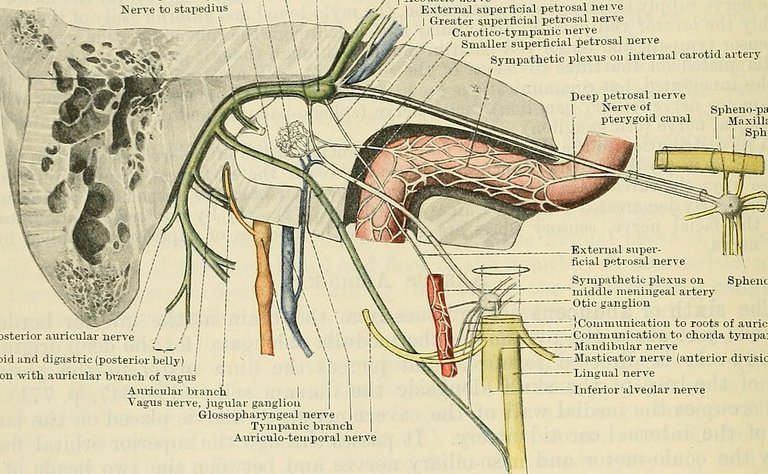Over the past few weeks, we have been looking into Neurology, and we have been going through the cranial nerves one after to other from the Olfactory Nerve (Cranial Nerve 1), Optic Nerve (Cranial Nerve 2), Oculomotor Nerve (Cranial Nerve 3), Trochlear Nerve (Cranial Nerve 4), Trigeminal Nerve (Cranial Nerve 5), Abducens Nerve (Cranial nerve 6), Facial Nerve (Cranial 7), and I also discussed the Vestibulocochlear nerve which I explained has two pathways, the Cochlear Pathway, and the Vestibular pathway. Today, I will be looking at another cranial nerve, and this time, it is the Glossopharyngeal Nerve (Cranial Nerve 9).
The Glossopharyngeal Nerve (Cranial Nerve 9) has its nuclei located in the medulla of the brain stem, which are the Nucleus Ambiguus, Nucleus Tractus Solitarius, inferior salivatory nucleus, and the dorsal nucleus of vagus. The word "Glosso" refers to tongue, and the word Pharyngeal refer to the region of the pharynx to the the nasal region.

Nucleus is a collection of neurons in the central nervous system (brain), working to perform a certain function
Ganglion is a neurons found outside the central nervous system
I will be explaining several sensory, efferent motor, and parasympathetic fibers which I wrote on in my previous post on the facial nerve, in this post. The fibers are the Special visceral Efferent (SVE) fibers, General Somatic Afferent (GSA) Fibers, General Visceral Efferent (GVE), Special visceral Afferent (SVA), and the General Visceral Afferent (GVA) fibers. {You can read more on this in the post (Neurology Explained - The Facial Nerve (The Seventh Cranial Nerve)}.
The Special visceral Afferent (SVA) fiber responsible for taste starts from the posterior one third of the tongue, and then moves to synapse into the Petrous ganglion (inferior ganglion of the glossopharyngeal nerve), and then continues through the Jugular foramen to the Nucleus Tractus Solitarius..
From the Nucleus Ambiguus, the Special visceral Efferent (SVE) fibers which supplies the third pharyngeal arches, moves through the Jugular foramen to supply the stylopharyngeus muscle of the soft pallet. It is important to know that all the muscles of the pharynx are innervated by the Vagus nerve (cranial nerve 10) except for the stylopharyngeus muscle which is supplied by the glossopharyngeal nerve (cranial nerve 9).,.
The General Somatic Afferent (GSA) fibers which supplies the external part of the ear (Pinna), external acoustic meatus, tympanic membrane, the pharyngeal tympanic tube, and the typanic cavity, for touch, temperature, and pain sensations. The GSA fiber moves through the superior gangion of the glassopharyngeal nerve, where its central processing fiber moves through the jugular foramen, after which it splits to supply the dura mater, while the other fiber goes into the spinal trigeminal nucleus (cranial nerve 5) in the medulla.,
The General Visceral Efferent (GVE) fibers in the glossopharyngeal nerve originates from the inferior salivatory nucleus through the jugular foramen, and then moves to the tympanic cavity, then to the tympanic canaliculus to give off the Jacobson nerve (tympanic branch) of the glossopharyngeal nerve which then goes to make up the tympanic plexus in the cochlear promontory.. From the tympanic plexus, a nerve branch known as the lesser petrosal nerve moves towards the middle cranial fossa, to the haitus of lesser petrosal nerve then to the foramen ovale along with the mandibular branch of the trigeminal nerve (Cranial Nerve 5), and then moves to the Otic ganglion, where the nerve moves to the perotid gland which produces saliva to the parotid duct then to the oral cavity.,,.
General Visceral Afferent (GVA) fibers of the glossopharyngeal nerve take visceral sensory touch and pain sensation to the oropharynx, the laryngealpharynx, the tonsils (Palatine Tonsils, and Lingual tonsils), and the carotid body. The GVA fibers from these regions goes to the central nervous system but synapse at the petrous ganglion, while the central nerve process goes through the jugular foramen after which they supply the Nucleus Tractus Solitarius, and the dorsal nucleus of vagus in the medulla.,.
Conclusion
The Nucleus Tractus Solitarius or the solitary nucleus is the major viseral sensory nucleus of the glosspharyngeal nerve responsible for taste, oral reception, and chemoreception. Another nucleus that plays an important role in the glossopharyngeal nerve is the spinal trigeminal nucleus (cranial nerve 5) which will carry general somatic information such as touch, pressure, temperature and pain to from the pinna, the external acoustic meatus, and the tympanic membrane. The Nucleus Ambiguus carry somatic motor fibers to stylopharyngeus muscle. The inferior salivary nucleus innovates the perotid gland which is responsible for the production of saliva.
Image Reference
Image 1 || Flickr || Cunningham's Text-book of anatomy
Neurology is a very important field of medicine. Even though some persons find it difficult, I am impressed at how you analyse it with ease.
Keep up the good works, there is always alot to learn from your blogs.
Thanks a lot for reading, I am glad you were able to read through my long boring post.
Thanks for your contribution to the STEMsocial community. Feel free to join us on discord to get to know the rest of us!
Please consider delegating to the @stemsocial account (85% of the curation rewards are returned).
Thanks for including @stemsocial as a beneficiary, which gives you stronger support.